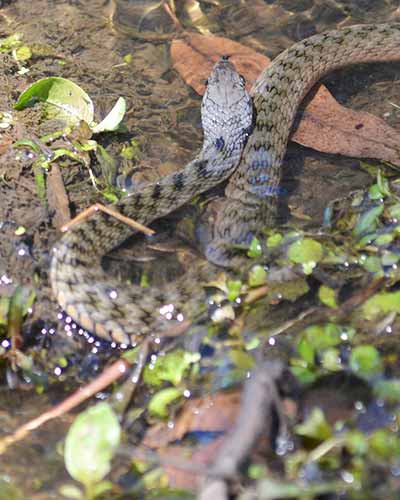Keelback
Snakes of South East Queensland
Keelback
Tropidonophis mairii
Other common names: Freshwater Snake, Water Snake, Swamp Tiger.

Species profile
Significance to Humans:
Non-venomous.
The Keelback Snake is Non-venomous. It is reluctant to bite but will if handled firmly. Generally strikes with mouth closed. Emits a strong odour from the cloaca which is immediately quite unpleasant if handled firmly.
General description:
Variable colouring but typically various shades of grey, brown or olive with irregular, broken cross-bands or flecks of darker brown and flecks of paler creamy colour. Belly surfaces cream or pale rusty colour with dark scale edges. Feature is each scale has a distinct raised longitudinal ridge or ‘keel’, giving the whole snake an appearance of parallel ridges down length of body. Assumably confused with the highly venomous Rough-scaled Snake (Tropidechis carinatus) which lacks a loreal scale and whose keeling of the scales is less defined. Midbody scales at 15 (rarely 17) rows.
Average Length:
As with many of the colubrid snake species the female Keelback attains a much larger size and length than do males. Male average size is around 45cm but females often reach a length of 65cm or more.
Habitat in SE Qld:
Common in moist localities within wet and dry forest environments. Persists along riparian margins and associated drainage lines well into farmland and suburban localities.
General habits:
This species is often associated with wetland and riparian areas but can persist in moist suburban backyards and parks. It can occur at quite high densities in favorable localities with the main consistent feature being proximity to water or damp riparian areas.
Diet:
The main components of this species diet is frogs, lizards and occasionally fish and tadpoles. Often noted for its ability to eat the introduced Cane Toad but only smaller toads and their tadpoles are generally targeted. The onus on this species to be considered a natural control for the Cane Toad is an over exaggeration of the ability of this snake to handle the toxin quantities found in larger specimens.
Local distribution:
Found throughout moist suburbs or areas where creeks and drainage lines, both natural and unnatural, persist. Often found in high numbers in suitable localities especially in the vicinity of marsh or dam habitats.
Around the home:
Often forages beneath low vegetation, logs, woodpiles, water features & moist areas etc, where potential prey may be found. Has been noted to exploit small fish in constructed backyard ponds.
Photo Gallery
Please be patient while our image gallery loads. If viewing images in the lightbox viewer by clicking on an image, please allow a few second between each image as some images are large to retain their quality and size. Images are loaded straight from Dropbox, if blank spaces appear in gallery please click on the refresh icon top left of gallery.
All image are the property of the website or respected owner and can not be re-used without permission. Copyright applies
Photo ID 
Did you know WildlifeQld offers a snake & Lizard identification service. For our identification service simply use the upload form on www.snakecatchers.com.au We provide our Australian snake identification service free of charge and always welcome high quality images for potential inclusion on our website. This service is not just for Queensland snake identification but for all snake id across Australia.
The content on this page is intended only to provide a summary and general overview . It is not intended to be comprehensive nor does it constitute to be exact in every circumstances. We attempt to ensure that the Content is current but we do not guarantee its currency.
